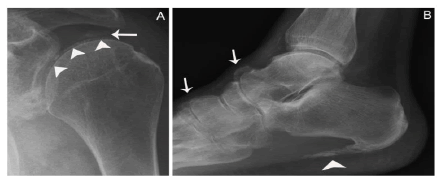Rheumatology: Current Research
Open Access
ISSN: 2161-1149 (Printed)
+44-77-2385-9429
ISSN: 2161-1149 (Printed)
+44-77-2385-9429
Image Article - (2018)Volume 8, Issue 3
A 72-year-old man with heart valve disease and dyslipidemia was referred to our arthritis unit due to diffuse pain and stiffness in the shoulder and pelvic girdle and a previous diagnosis of probable polymyalgia rheumatica with no significant improvement with glucocorticoids. After evaluation, a diagnosis of pseudopolymyalgia rheumatica syndrome due to pyrophosphate arthropathy was made. Radiographs showed typical polyarticular chondrocalcinosis in several joints including the hips and shoulders (Figure A). Secondary causes of pyrophosphate arthropathy were ruled out. The clinical course remained stable for fifteen years, without joint flares. However, after discontinuation of colchicine due to hospitalization for cardiac valve replacement surgery, which was complicated by septic pericarditis and renal failure, the patient complained of severe neck and ankle pain. Acute phase reactants were elevated and septic arthritis was ruled out. A progressive clinical improvement was achieved with analgesics, glucocorticoids, and resumption of colchicine. Cervical X-ray showed chronic degenerative changes, chondrocalcinosis in the intervertebral discs, and marked extensive calcification in the plantar fascia compatible with chondrocalcinosis, together with chondrocalcinosis in the tarsal joints (Figure B).

Pseudopolymyalgia rheumatica syndrome may be a presenting form of pyrophosphate arthropathy [1]. The radiological appearance of chondrocalcinosis is typical, affecting mainly the fibrocartilaginous structures, but also the hyaline cartilage. The tendons and entheses may be involved, especially in patients with large amounts of pyrophosphate deposits [2] including Achilles tendon and plantar fascia [3].
This manuscript has no financial support, nor any of the authors has benefits from commercial sources, or any other financial interests that could create a potential conflict of interest to disclose.
Citation: Camacho O, Castellanos-Moreira R, Rodriguez-Garcia SC, Sanmarti R (2018) Extensive Chondrocalcinosis in the Plantar Fascia. Rheumatology (Sunnyvale) 8: i005. doi:10.4172/2161-1149.1000i005
Received: 29-Aug-2018 Accepted: 31-Aug-2018 Published: 04-Sep-2018
Copyright: © 2018 Camacho O, et al. This is an open-access article distributed under the terms of the Creative Commons Attribution License, which permits unrestricted use, distribution, and reproduction in any medium, provided the original author and source are credited.